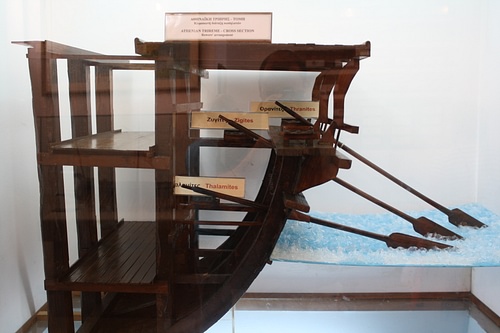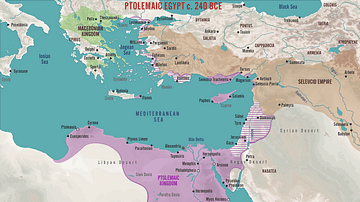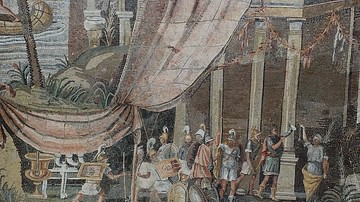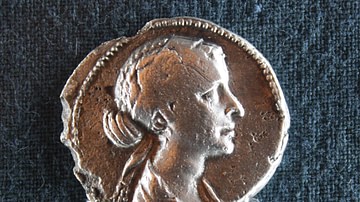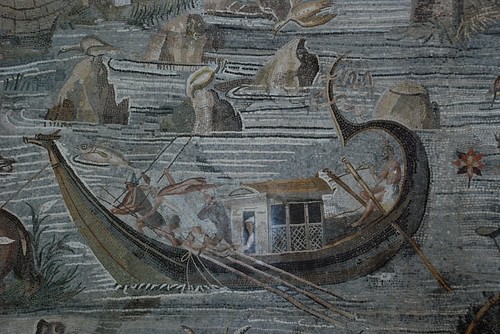
Ptolemaic Egypt was a naval power that exerted influence throughout the Eastern Mediterranean from its foundation in 330 BCE until Cleopatra's defeat by Augustus at the Battle of Actium in 30 BCE. The Ptolemaic Kingdom produced some of the largest human-powered ships of all time, and the largest and most advanced warships of the period.
The Ptolemaic navy was also used to patrol trade routes on the Mediterranean, the Red Sea, and the Nile as a way to deter piracy. Ptolemaic exploratory expeditions helped to improve Greek and Roman geographical knowledge of Arabia and the Indian subcontinent. Despite the overall decline of its military might in land conflicts, it remained a relevant naval force until the end of the dynasty.
Origins
Alexander the Great (r. 336-323 BCE) conquered Egypt in 332 BCE, and after the death of Alexander the Great in 323 BCE, it was ruled by his general Ptolemy I (r. 305-282 BCE). The rest of Alexander's empire was divided between his other generals in the Wars of the Diadochi. The Diadochi and their successors waged constant wars against each other for territory and resources, which spurred on the development of the Ptolemaic navy.
Ptolemy I's navy originally consisted of the forces left behind by Alexander the Great in 331 BCE. 30 triremes were left in Egypt by Alexander under the command of the admiral Polemon. After defeating the Macedonian general Thibron in Cyrene in 324 BCE, Ptolemy probably absorbed what remained of Thibron's fleet. He also made alliances with the rulers of Cyprus, which enabled him to build additional warships.
By 306 BCE, Ptolemy I was able to muster 210 warships and 200 troop transport ships. Ptolemy's brother Menelaus led this fleet against the forces of Demetrius I (c. 336 to c. 282 BCE) at Salamis of Cyprus. Demetrius, whose fleet contained larger ships carrying artillery, annihilated the Ptolemaic fleet. 40 warships and 8,000 Ptolemaic marines were taken captive by Demetrius. This catastrophic defeat meant that Ptolemy I was unable to maintain control of Cyprus and Coele-Syria, which were lost to Antigonus I. Within a decade, Ptolemy I had rebuilt a fleet of 150 ships which he used to recapture Cyprus and take control of Lydia, Tyre, Sidon, and Pamphylia.
He takes slices of Phoenicia and Arabia and Syria and Libya and the dark-skinned Ethiopians; all the Pamphylians and the warriors of Cilicia he commands, and the Lycians and the Carians, who delight in war, and the islands of the Cyclades, for his are the finest ships sailing the ocean. All the sea and the land and the crashing rivers are subject to Ptolemy.
(Theocritus, Idylls, 17.86-95)
Under Ptolemy II (r. 282-286 BCE) and Ptolemy III (r. 246-222 BCE), the Ptolemaic navy rapidly expanded with new and more advanced warships to become the dominant naval power in the Mediterranean. This navy enabled the Ptolemaic dynasty to capture and defend islands and coastal territories that stretched from Egypt to the Aegean, making the Ptolemaic Kingdom into a thalassocracy. Later Ptolemaic rulers would continue to prioritize the maintenance of a large fleet, but by the end of the dynasty, its global power had disintegrated.
Naval Engineering
The Ptolemaic fleet was made up of Greek ships, including warships for naval combat and troop carriers for transporting soldiers. These ships could travel under oars or sails, depending on conditions, and travel at a rate of approximately 50 miles per day. The different types of ships used in Greek naval warfare were usually named for how many rows of oars they had. A trireme, the classic warship of antiquity, had three rows of oars layered on top of each other. In the Hellenistic period, different states competed to build larger ships called polyremes, which had five or more rows of oars.
The Ptolemaic Kingdom led this race, building warships with 20, 30, and 40 rows of oars. These larger ships are thought to have been double-hulled catamarans. The naval architect Pyrgoteles son of Zoes designed both the 20s and 30s. Ptolemy II was so impressed by these ships that he commemorated Pyrgoteles with his own statues in the temple of Aphrodite on Paphos. The Hellenistic author Callixeinus of Rhodes (2nd century BCE) and Roman author Appian claim that Ptolemy II had over 4,000 ships, but this number was greatly exaggerated. The fleet under Ptolemy II probably had at least 300 warships, with a third of these being polyremes.
Large numbers of architects, craftsmen, and construction workers were needed to continuously build and repair these ships. Alexandrian engineers pushed the boundaries of ship construction, siege engines, and on-deck artillery. The Ptolemaic engineer Philo of Byzantium (c. 3rd or 2nd century BCE) covered various aspects of naval and siege warfare in his Compendium of Mechanics. The topics covered included building and transporting artillery and siege equipment, storing water safely, and building harbors.
Warships had to be made of strong, lightweight wood like fir or cedar. The keel was typically a single beam of oak wood, which had been forced to grow in a curved shape. Trees of sufficient length and quality for shipbuilding did not grow in ancient Egypt, so wood had to be imported. Cyprus was one of the Ptolemaic Kingdom's most important wood-producing provinces. The Ptolemaic dynasty also fought with the Seleucid Empire over control of timber-producing territories in Coele-Syria, Cilicia, and Phoenicia. The cost of building ships was usually paid for with royal tax revenue, although sometimes high-ranking officials contributed their own money towards the construction of a warship.
Crew
The majority of a Hellenistic warship's crew were oarsmen, followed by sailors and marines. The job of ancient marines was to attack enemy ships with projectiles and, if possible, attempt to board them. A trireme required a crew of around 170 oarsmen and 30 sailors, while a quinquereme required 270 oarsmen and at least 40 sailors. The number of marines on board would have varied. Historian Christelle Fischer-Bovet estimated that the fleet might have employed anywhere between 45,000 and 50,000 crew members in peacetime, and 70,000 to 80,000 crew members in wartime.
Despite their size, Ptolemaic vessels were cramped spaces with very little living room. Crew members were provided with some rations, but the provision of large navies required an accompanying fleet of merchant ships carrying food, freshwater, and other supplies. Without adequate supply lines, navies were at risk of starvation, sickness, and low morale. Fleets also needed to stay close to the shore so that they could resupply and rest, which was easier in regions where they had allied bases.
Triremes were not particularly seaworthy craft, and there was little room on board for food, water and firewood. Thus crews tried to find a friendly beach each night to cook their meals and sleep. However, they and their ships could fall prey to enemy land forces at such times.
(Rawlings, 120)
The majority of Egyptians in the early Ptolemaic military served in the navy rather than the Ptolemaic army, particularly as marines and oarsmen. The captains and admiralty were typically Macedonian or Greek. Oarsmen were often conscripted into compulsory service and were of a lower social status than marines, although they received fairly high pay. The poor treatment of crew members inspired rebellions, which often resulted in the government promising better treatment to oarsmen and sailors.
The average pay of a crew member could be one drachma per day, depending on their rank and experience. More experienced crews required less training and preparation and could be deployed faster. They were also more reliable in combat and better able to perform complex tactical maneuvers. Because of this, the outcome of ancient naval battles was often determined by the quality of their crew.

Patrol & Maritime Policing
In addition to waging war, the Ptolemaic navy was also used to patrol seas and rivers under Ptolemaic control. Law enforcement in Ptolemaic Egypt protected commerce by guarding merchant vessels and harbors. Small, agile ships patrolled inland rivers to prevent banditry and other crimes, while larger fleets patrolled the Mediterranean and Red Sea. The most important body of water was the Nile River, which flowed through Egypt like a superhighway. Traveling on the Nile was significantly faster than traveling by land, so it was a major conduit for communications and trade, and policing the Nile was vital.
Despite the Ptolemaic reputation for naval power, the navy had a terrible record in actual naval combat. It was, on the other hand, far better at supporting the Ptolemaic network of fortified possessions all around the Mediterranean and Aegean, as well as the Red Sea and up and down the Nile. (Johstono, 265)
Egypt's Red Sea coast was economically important due to trade with East Africa, India, and Arabia. Piracy was an ever-present threat on the Red Sea, which the Ptolemaic dynasty used its navy and hired mercenaries to prevent. A Strategos and Epistrategos of the Red Sea and Indian Ocean, equivalent to an admiral or governor, was appointed after the 2nd century BCE. The strategos was probably tasked with protecting diplomatic and economic traffic on these waters.
As leaders of the League of Islanders in the early 3rd century BCE, the Ptolemaic navy also defended Greek city-states in the Cyclades islands from piracy in the ancient Mediterranean. At the same time, there is considerable evidence that Ptolemaic kings and admirals also allied with pirates on occasion. The Roman historian Strabo (c. 62 BCE to 24 CE) reported that Ptolemaic kings worked with pirates who enslaved captives from Seleucid territory in the eastern Mediterranean. Similar arrangements likely took place in the Aegean.
Exploration
The Ptolemaic fleet was used to explore the maritime frontiers of the Hellenistic world, charting lesser-known parts of Arabia and Africa. The purpose of these expeditions was to find new sources of wealth or war material for the Ptolemaic state. Because these voyages reached previously mysterious destinations, their reports were extremely useful to Greek and Roman geographers. Timosthenes of Rhodes, an admiral during the reign of Ptolemy II, introduced a compass rose based on the cardinal directions and geographic origins of twelve winds which became widely used in ancient navigation.
Under Ptolemy II, various naval expeditions led by Ptolemaic admirals were sent into the Red Sea to scout trade routes and find a reliable source of war elephants. The admiral Ariston explored the Arabian coast, while the admiral Satyros explored the Red Sea coast of Egypt, looking for information on the best elephant hunting grounds. While there, Satyros founded the town of Philotera, which was named after one of Ptolemy II's sisters.
The Indian subcontinent was also further explored during this period. Eudoxus of Cyzicus was sent on two voyages to India between c. 117 and 107 BCE. According to Posidonius (c. 135-51 BCE), Eudoxus' journey was made possible by a shipwrecked Indian navigator who helped them understand how to sail directly to India without having to make frequent stops along the Arabian coast. The result of these discoveries was increased trade and diplomacy between India and Egypt.

